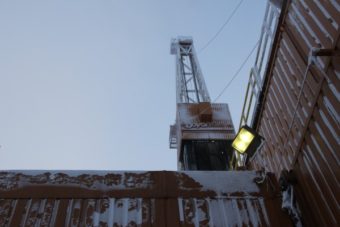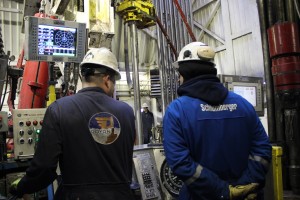For 40 years, Alaska’s North Slope oil production has taken place on a stretch of state land sandwiched between two major federal reserves: to the east is the Arctic National Wildlife Refuge. To the west, the much larger National Petroleum Reserve Alaska — which, despite its name, never produced any oil until this fall.
ConocoPhillips hopes to change that in a big way. Despite oil prices hovering around $30 a barrel, the company is plowing ahead with efforts to develop the NPR-A. The company invited Alaska journalists on a tour last week of CD5, the first drill site to produce oil in the reserve — and, the company hopes, the gateway to more development.
The 7 a.m. flight to the Kuparuk oil field took off from Anchorage with a dozen reporters joining the regular commuting crowd.
“Good morning ladies and gentlemen, once again welcome aboard Shared Services Flight 151 with service to Kuparuk,” the flight attendant said.
This is the only way to reach Kuparuk, on a flight operated and paid for by ConocoPhillips and BP’s Shared Services, which ferries more than 26,000 workers a month to and from the North Slope oil fields.
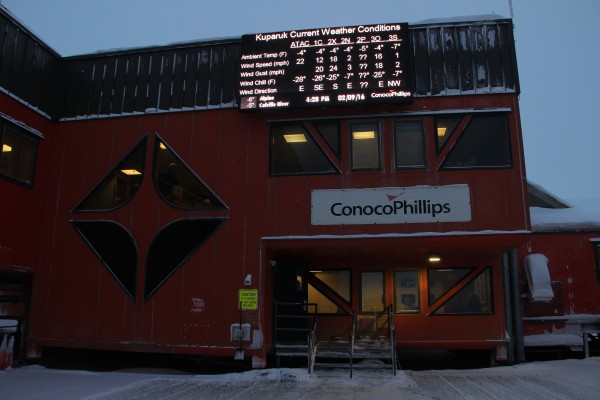
When we landed, it was -7 degrees. In the morning half-light, the scene, with its modular buildings, heavy equipment, steam rising in the distance and sweeping wind felt more than a little otherworldly. One reporter commented that this must be what it will look like when we colonize other planets.
Kuparuk can house up to 2,500 people, and keeping them all fed, safe and comfortable is an operation in and of itself.
“We’re like a little city,” said operations manager Ty Maxey. “We have our own power system, our own wastewater treatment system, our own potable water treatment system.”
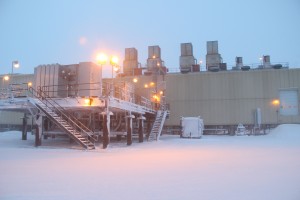
Alaska’s most famous field, of course, is Prudhoe Bay, operated by BP. Discovered in 1968, it’s still the largest oil field in North America.
Conoco’s Kuparuk River Unit is 40 miles west of Prudhoe and only slightly less massive. It began operations in 1981.
West of Kuparuk is Alpine, in the Colville River delta. It came online in 2000.
Alpine has about 450 people right now.
“Kuparuk is the big brother for Alpine. That’s for sure,” said Steve Thatcher, the operations manager at Alpine. “It’s much bigger, much more complicated field. But Alpine is where we’re growing.”
The newest development at Alpine is CD5. The drill site is on a tentacle of road stretching west from Alpine, and sits just inside the National Petroleum Reserve. The billion-dollar project started producing oil in October – the first from the NPR-A – and is eventually expected to produce about 16,000 barrels per day.
Conoco hopes CD5 will be both the gateway and launch pad for development in the rest of the NPR-A. From CD5, Conoco plans to build a road to its next development, Greater Mooses Tooth 1. And from there, if it gets through permitting, to Greater Mooses Tooth 2.
So today we’re traveling west from Kuparuk. If you remember just one thing, that’s it. This is what Conoco is doing on the North Slope. Marching west.
There is no permanent road connecting Alpine and Kuparuk. Instead, during the winter, the two units are linked by a 25-mile ice road.
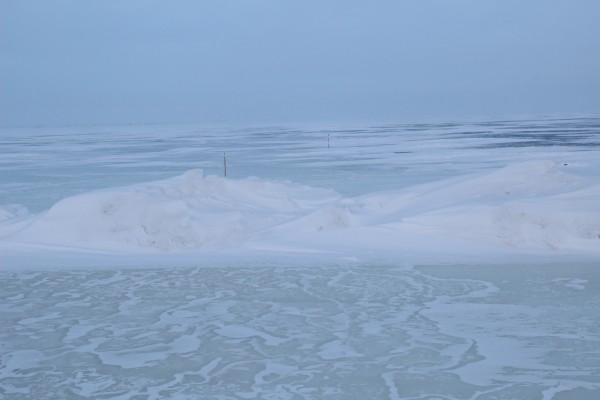
Built with ice chips harvested from lakes along the route, the ice road is rebuilt every winter, at a cost of $20 million each time. In the summer, it melts into the tundra, leaving Alpine accessible only by plane.
Roads — their presence or absence — are a big deal on the North Slope, and often one of the hardest things to get regulators to approve.
It took 10 years to permit CD5, in no small part because the project required a 6-mile gravel road and four bridges, including one over the Nigliq Channel of the Colville River. At 1,400 feet, it’s the largest bridge on the North Slope.
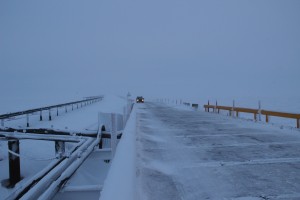
The road passes through a key subsistence fishing area for the village of Nuiqsut, which is just 8 miles from Alpine.
Though it’s inside the NPR-A, CD5 is actually on land owned by the Nuiqsut village corporation, Kuukpik. The road was controversial, and the village insisted Conoco change the bridge location.
“CD5 came a long way,” said Kuukpik Corp. President Isaac Nukapigak. “In the beginning we had a little disagreement over where the project itself should be developed. We were able to compromise on a way of responsible development.”
Kuukpik, he said, aims for “balance.”
As for development farther west in NPR-A, Nukapigak said, his view is it’s going to happen one way or another, and Nuiqsut needs to have a seat at the table.
As we drove up to CD5 itself, a Doyon drill rig emerged from the fog, sitting crouched on the pad like a rocket, not far from some caribou. At 12 acres, the pad itself was crowded with equipment. Our bus nearly caused a traffic jam. Inside, the sound was deafening, and the crew was busy at work on an injection well, the newest well on Alaska’s North Slope.
